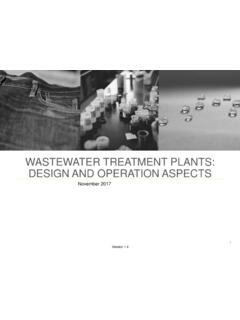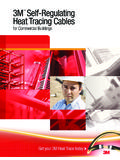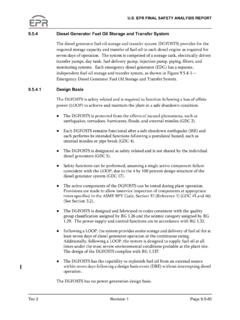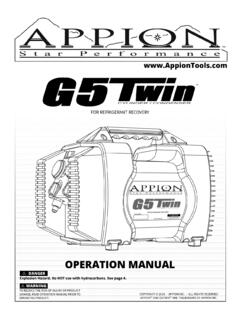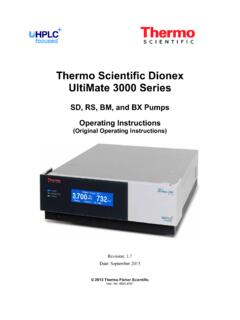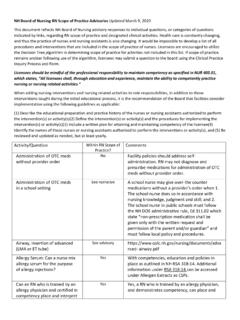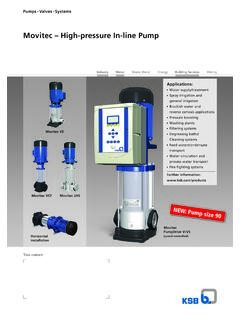Transcription of Design of Purified Water and Water For Injection Systems
1 Design of Purified Water and Water For Injection SystemsHugh Hodkinson Engineers Ireland Chemical & Process DivisionIntroduction My Background What s this lecture about? What should you get out of it?- Learn basic Design rules for PUW & WFI- Understand where they came from- Know enough to query a designWhat are PUW and WFI? Compendial Waters as classified by national and international organisations such as: United States Pharmacopoeia (USP) European Pharmacopoeia (Ph. Eur) Japanese Pharmacopoeia (JP)What are PUW and WFI used for?
2 Product contact operations Typical PUW uses: Bulk API or BPC Preparation Non parenteral dosage forms Laboratory activities Cleaning of the above and initial rinses for the below Typical WFI uses: Sterile Bulk API or BPC Preparation Parenteral dosage forms Final cleaning rinses for the above two applicationsPurified WaterParameterUnitUSPPh. Eur. (Bulk)TOCppb C500500 Conductivity S/cm @ 20 C- S/cm @ 25 C (NO3)ppm- Metalsppm as Pb- Bacteria CFU/ ml 100 100 Water For InjectionParameterUnitUSPPh. Eur. (Bulk)TOCppb C 500 500 Conductivity S/cm @ 20 C- S/cm @ 25 C (NO3)ppm- Bacteria CFU/ 100 ml 10 10 Bacterial EndotoxinsEU/ ml do we monitor these parameters?
3 Conductivity: Ionic Contaminants TOC:Food for microbes Nitrates:Negative health impacts Heavy Metals:Toxic to humans and animals Aerobic Bacteria:Unwanted organisms Endotoxins:Dangerous in parenteralsHistory of Compendial Water Introductions to USP Prior to Nov. 1996: Sulfate1840 Calcium1840 Carbon Dioxide1850 Chloride1890 Ammonia1890 Oxidizable substances1890 Heavy Metals1900 Coliforms1947 Total Solids1947 pH1970 Bacterial endotoxins1983 Why do we care about temperature? ( S/cm) vs. Temperature ( C)Conductivity ( S/cm)PUW GenerationHow is PUW made?
4 By use of some or all of the following: Particulate Filter Activated Carbon Organic Scavengers Softeners Degassing Membrane Ion Exchange Columns/ Continuous Electro De-Ionisation Reverse Osmosis UV LampWFI GenerationHow is WFI made? In Europe, WFI can only be produced by distillation USP allows for WFI production by RO or by distillation JP allows for WFI production by RO, distillation or Ultra-Filtration Two main still designs: Vapour Compression and Multi-EffectMulti-Effect Still SchematicVapour Compression Still SchematicWhat is WFI made from?
5 Its feedwater does NOT have to be PUWC haracteristicRequirementpH at 20 at 20 C< 10 S/cmDissolved Solids< 5 mg/lChlorides< 50 ppbFree Chlorine < 50 ppbAmmonia< 50 ppbTotal Hardness< 2 ppmSilica as SiO2< 1 ppmEndotoxins< 250 EU/mlPUW/ WFI Storage and Distribution Ensure that it stays as PUW/ WFI Minimise microbial growth Keep it moving Heat, chilling or ozonation Regular sanitisation Polished surfaces: Ra < m is common Prevent any contamination from entering Sealed system with m vent filters for breathing Block and bleed assemblies at user points Double sheet shell and tube/ double plate heat exchangers Use materials which won t degrade Water quality, such as 316 or 316L stainless steel, PTFE, EPDM, PUW/ WFI Storage and DistributionHot PUW/ WFI Storage and Distribution with Cooled Sub-LoopOzonated PUW Storage and DistributionPUW/ WFI Storage and Distribution.
6 Three Sub-LoopsEconomiser Heat ExchangerSub-Loop Flush to DrainPumped Cooling Sub-LoopPoint of Use CoolingBlock and Bleed PUW/ WFI User PointGeneral Design Principles Sanitary diaphragm valves used throughout system Single mechanical seal centrifugal pumps Every line slopes to drain Consider designing system for steaming Recommend envelope gaskets (PTFE encapsulated EPDM)Construction Very important step which is often overlooked by commissioning team Weekly walkdowns Inspect welds from day 1 Review degreasing, pickling and passivation proceduresVital Construction Activity.
7 FlushingInstall Mesh Gaskets in PUW/ WFI return header throughout commissioning A flush exercise which is a few hours long will not remove all particles from the loop Many contaminants, such as stainless steel shavings, will not register on a TOC meter or conductivity meter Recommended to have mesh gaskets installed for days or weeks: throughout commissioning phaseAutomation Build automation into the Design from day one. Crucial to a successful project. Develop URS in tandem with P&IDs The software cannot be properly developed unless there is a detailed Design document (URS or related document).
8 Detail to include: Process Sequences Interlocks AlarmsCommissioning Test key Design fundamentals: Velocities Slopes Deadlegs Temperatures Water Quality (Sampling)Commissioning Optimise Operation: Efficient and effective sanitisation Operational sequences as per Design documents Stress Testing Basis of Verification Process System Data GatheringSampling Build Sampling into Design Recommended to allow capability to sample at the following points, at a minimum: Generation System Infeed Generation System Outfeed As close as possible to each User PointRouging Rouging is a film of iron oxides and hydroxides Rouging is common in PUW, WFI and Pure Steam Systems Rouging is acceptable in these Systems , however it is recommended to monitor rouging and minimise rouge levels passing into the productRouging Class 1: Caused by contamination from external sources, carbon steel particles getting into a PUW/ WFI/ PS (pure steam) system.
9 This SHOULD never happen, as all good contractors are very stringent about separation of carbon steel stores from stainless steel stores, using separate tools for carbon steel and stainless steel, etc. If this type of contamination is in the PUW/ WFI/ PS system, I'd recommend shutting it down, draining, passivating, refilling and restarting. An investigation would have to be launched to determine how the contamination entered the Class 2: Rouging in PUW/ WFI Systems : These Systems will always rouge, especially if they are > 60 C.
10 This does not affect the Water quality, but it is good practice to Design these Systems to minimise rouging. Rouging Class 3: Rouging in Pure Steam Systems : These Systems will rouge quickly. This does not affect the PS quality, but it s worth considering putting the PS through a steel mesh before it reaches a critical process step. I'd recommend a 1 m mesh United States Pharmacopoeia 788, Particulate Matter in Injections states maximum particle size 25 m. Rouge particles are typically 1 m in diameter, but theoretically could clump.

